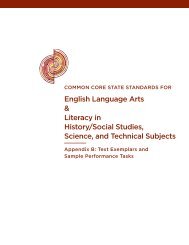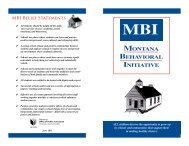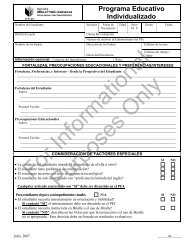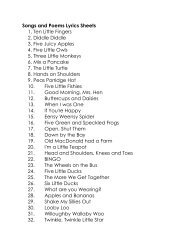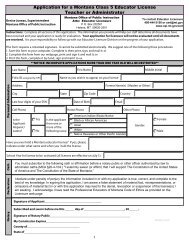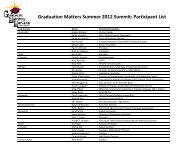OT/PT Guidelines - Montana Office of Public Instruction
OT/PT Guidelines - Montana Office of Public Instruction
OT/PT Guidelines - Montana Office of Public Instruction
Create successful ePaper yourself
Turn your PDF publications into a flip-book with our unique Google optimized e-Paper software.
19. Are specific goals for consultation required only when an <strong>OT</strong> or <strong>PT</strong> is providing<br />
consultation, or can the consultation be to support goals already on the IEP by another<br />
service provider?<br />
The <strong>OT</strong> or <strong>PT</strong> is not required to have a specific <strong>OT</strong> or <strong>PT</strong> goal whether providing consultation<br />
and/or direct services. Regardless <strong>of</strong> how services are provided, the pr<strong>of</strong>essional should be<br />
supporting discipline-free IEP goals <strong>of</strong> the student. There may be instances in which an <strong>OT</strong> or<br />
<strong>PT</strong> is providing a related service, such as monitoring equipment for fit or for working<br />
condition, range <strong>of</strong> motion (ROM) activities, etc. These activities would be listed as IEP<br />
services with frequency, location, and duration.<br />
20. Who collects data on student IEP goals?<br />
Any staff member that works with the student can collect data. The <strong>OT</strong>s and <strong>PT</strong>s should be<br />
aware <strong>of</strong> data collection strategies that can be used as a part <strong>of</strong> the school routine; then, select<br />
or create the best strategy to implement for data collection procedures. Once the best match<br />
has been found, it is important to be consistent. It is also important to consult with other<br />
service providers to educate them on how to use the data collection procedure.<br />
21. When providing consultation services, one time per month or one time per nine-week<br />
period, is there a best practice guideline for how to write that amount <strong>of</strong> time and<br />
frequency?<br />
The written narrative should clearly state what services a student is receiving, in what<br />
environment, and how <strong>of</strong>ten. If the student is being seen one time a month, this should be<br />
clearly noted on the IEP so that parents and colleagues easily understand this section.<br />
22. What is the criterion for exiting a student from <strong>OT</strong> and <strong>PT</strong> services?<br />
The IEP teams are encouraged to begin the discussion <strong>of</strong> exiting services when initial<br />
eligibility is determined. Discussing exit criteria early in the special education process helps<br />
parents reduce uncertainty about giving up services. Exit criteria must be individually<br />
determined and must comply with IDEA requirements. As IEP teams customize exit criteria<br />
according to student need, these decisions should be informed by what is known about the<br />
student and research on the efficacy <strong>of</strong> interventions and services. The IEP teams should<br />
prioritize student needs when designing exit criteria and seriously consider the effective use <strong>of</strong><br />
learning time.<br />
23. Is extended school year (ESY) provided in the <strong>OT</strong> and/or <strong>PT</strong> areas?<br />
It may be. This is a determination <strong>of</strong> the IEP team. Every child with an IEP has the right to<br />
have ESY explored as part <strong>of</strong> their IEP meeting. Extended school year services are<br />
provided for those students who demonstrate a regression in skill level over breaks<br />
(summer break, winter break, spring break). Skills that have been mastered are lost during<br />
30



